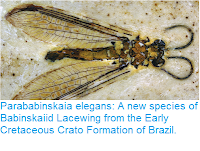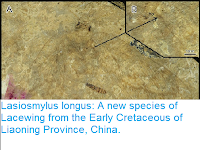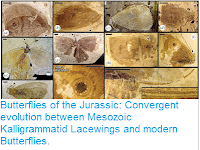The Neuroptera, or Net-winged Insects, first appeared in the Permian and
reached their maximum diversity in the Permian, when they were the most
numerous Insects in many ecosystems. They are non-metamorphic Insects,
in that they do not go through a dramatic metamorphosis on reaching
maturity in the way that Butterflies or Wasps do, but rather the larvae
grow progressively more like the adults with each molt Nevertheless the
larvae are often quite different from the adults and may have quite
different ecological roles. Today the Neuroptera are somewhat of a relic
group, with many of the Jurassic groups having become extinct and most
of the surviving groups having much lower diversity. One group that are
still very successful today are the Green Lacewings, Chrysopidae, with
around 2000 species in about 85 genera found living around the world. This group was already well established by the Eocene, with 21 species described, all from North America.
In a paper published in the journal Zootaxa on 27 September 2017, Bruce Archibald of the Department of Biological Sciences at Simon Fraser University and Vladimir Marakin of the Federal Scientific Center of the East Asia Terrestrial Biodiversity of the Far East Branch of the Russian Academy of Sciences, describe a new species of Green Lacewing from an Early Eocene lacustrine shale exposed in the Driftwood Canyon Provincial Park of British Colombia.
The new species is placed in the genus Lithochrysa, which contains one previously described species, from the Eocene of Colorado, and given the specific name borealis, meaning 'northrn'. The species is described from an overlapping partial forewing and hindwing (fossil Insect species are often described from their wings, the venation of which is highly diagnostic).
Wings of Lithochrysa borealis. (A) Specimen as preserved, a crumpled forewing overlaying a partial hind wing; (B) forewing venation (hind wing not shown). Scale bar is 1 mm. Archibald & Makarin (2017).
See also...
Follow Sciency Thoughts on Facebook.







